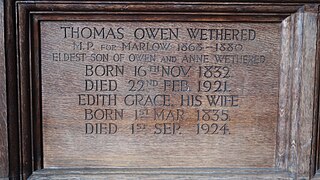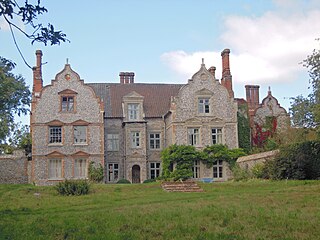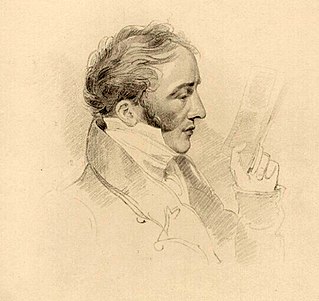
General Sir George Wentworth Alexander Higginson, was a British Army officer and veteran of the Crimean War who served more than 30 years in the Grenadier Guards.

Marlow is a town and civil parish within the Unitary Authority of Buckinghamshire, England. It is located on the River Thames, 4 miles (6 km) south-southwest of High Wycombe, 5 miles (8 km) west-northwest of Maidenhead and 33 miles (53 km) west of central London.

Capesthorne Hall is a country house near the village of Siddington, Cheshire, England. The house and its private chapel were built in the early 18th century, replacing an earlier hall and chapel nearby. They were built to Neoclassical designs by William Smith and (probably) his son Francis. Later in the 18th century, the house was extended by the addition of an orangery and a drawing room. In the 1830s the house was remodelled by Edward Blore; the work included the addition of an extension and a frontage in Jacobean style, and joining the central block to the service wings. In about 1837 the orangery was replaced by a large conservatory designed by Joseph Paxton. In 1861 the main part of the house was virtually destroyed by fire. It was rebuilt by Anthony Salvin, who generally followed Blore's designs but made modifications to the front, rebuilt the back of the house in Jacobean style, and altered the interior. There were further alterations later in the 19th century, including remodelling of the Saloon. During the Second World War the hall was used by the Red Cross, but subsequent deterioration prompted a restoration.
Lieutenant-Colonel Sir Walter Henry Bromley-Davenport TD DL was a British Conservative Party politician.
Sir Walter Wagstaffe Bagot, 5th Baronet of Blithfield Hall, Staffordshire was an English Tory politician who sat in the House of Commons between 1724 and 1768.

Brigadier-General Sir William Bromley-Davenport, was a British soldier, footballer and Conservative politician. He fought with distinction in both the Second Boer War and the First World War. An MP from 1886 to 1906, he held political office under Arthur Balfour as Financial Secretary to the War Office from 1903 to 1905.
Wadham Wyndham (1793–1849) DL JP was the eldest son of Colonel Wadham Wyndham and an influential figure in Tory politics in the first half of 19th century Britain.

Marlow Urban District was a local government authority in the administrative county of Buckinghamshire, England, between 1896 and 1974, covering the town of Marlow.

William Bromley-Davenport, also known as Davenport and Davenport-Bromley, was an English Conservative politician who sat in the House of Commons from 1864 to 1884.

Thomas Owen Wethered was an English Conservative Party politician and brewer who sat in the House of Commons from 1868 to 1880.
Francis Bromley was an English politician. A member of an important legal and landowning dynasty of the Shropshire landed gentry, his career was cut short by an early death. He was a Member (MP) of the Parliament of England for Shropshire in 1584.
James Chase, of Westhorpe House, Little Marlow, Buckinghamshire. was an English apothecary and Whig politician who sat in the English and British House of Commons from 1690 to 1710. From 1690 he was Court apothecary to King William III, Queen Anne and King George I.

Sir William Clayton, 4th Baronet of Harleyford Manor, near Great Marlow, Buckinghamshire was an English politician.

Soughton Hall is a Grade II* listed country house hotel in Sychdyn, Flintshire, Wales. Notable guests that have stayed include Luciano Pavarotti, Michael Jackson and King Juan Carlos I of Spain. William John Bankes inherited Soughton Hall in the 1815.

Latimer House is a large country house at Latimer, Buckinghamshire. It is now branded as De Vere Latimer Estate and functions as a countryside hotel used for country house weddings and conferences. Latimer Place has a small church, St Mary Magdalene, which was built by Lord Chesham, in the grounds.

Wiveton Hall is a country house in Wiveton, Norfolk, England. It is Grade II* listed. It was built in 1652 and extended in 1908. However there are remains of an older building in the garden which could date back to 1280. It was the residence of many notable people over the next three centuries and is now the home of the MacCarthy family. The Hall provides holiday cottage accommodation, a restaurant café, a farm and gift shop and has garden tours. The West Wing is available for weddings and other special events.
Sir William Arthur Bromley-Davenport, KCVO is a British landowner, accountant and public servant.

Marlow Town Hall is a municipal building in the Market Square, Marlow, Buckinghamshire, England. The structure, which was used as a public events venue, is a Grade II* listed building.
Davies Davenport of Capesthorne Hall and Court Garden, Marlow was a politician, soldier and landowner who served as Member of Parliament for Cheshire and High Sheriff of Cheshire.

Edward Davies Davenport of Capesthorne Hall was a British landowner, High Sheriff of Cheshire and Member of Parliament for Shaftesbury.

















